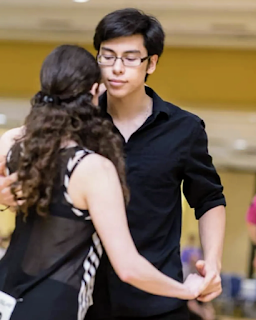He said/she said
I've been dating dancers since 2011. And, accompanying that, practicing with romantic or at least non-platonic partners for the same length of time. It's only natural that we become interested in people who share our hobbies, passion projects, and way of life. It's also very natural to want to practice and get better with these same people. It just makes sense, right? You want to improve, you support their improvement, maybe you even live together....
And it doesn't have to be unhealthy. It can be constructive!
Twelve-ish years (more than eight of them, now, doing west coast swing) have included a fair share of ups and downs, healthy and unhealthy interactions with partners.
It's also included plenty of purely platonic practice partners, and range of different levels of success and productivity there, too.
Maybe due to this experience, and a lot of thought (and therapy, and discussion with uninvolved friends, and working with my own teachers and coaches) I've become fairly successful at helping couples who dance work together a bit better.
***
This might become a series. In the meantime, feel free to hit me up on social media regarding lessons or video critiques ;)
***
A lot of times, a less than positive emotional interaction will stem from a dance interaction that left one person unhappy or frustrated.
"Why didn't you do__?"
"Well, I could've done__ if you just__!"
"I'm trying to do__ and it's really important for me to prioritize this right now"
"Okay but it's keeping me from__ and how am I supposed to __ under these circumstances?"
"Okay but it's keeping me from__ and how am I supposed to __ under these circumstances?"
...And so on, and so forth.
So. Here's a little to-do list.
1. If anyone is in pain/possible risk of injury, they get the talking stick first. It isn't the end of the world to have to adjust something seemingly vital in order to keep your partner safe. However, after learning how to make that adjustment; it's probably a good idea to find out how they can avoid said painful situation all by themselves -- if only to remain safe out on the social floor with other people.
Now, person 'A' is the one who makes the first remark. Person B is responding.
2. Person B shares what they were trying to accomplish first. If you (person A) were frustrated with the dance interaction, it's important that your partner not feel like they're being piled onto with complaints. Let's say I'm following you and there's something going on with your cutoff whip that I don't like. We don't start with me (person A) laying out everything I think you're doing wrong -- we start with you outlining how you want your cutoff whip to go, in your ideal world. Person A does not critique what person B is doing, or asking for, or how they are doing it. Their only job is to understand person B's ideal. In this scenario, it's my job to listen and understand what you want with this cutoff whip -- my opinion of it doesn't matter.
This means I need to care about what you have to say and root for your success. And it ensures that you feel heard and valued.
3. Next, we immediately go to what person A wants to happen. Keeping the same example, now that I get what you're trying to accomplish with the cutoff whip I do not give any feedback on what you just said. We switch gears to what my ideal cutoff whip is, from the follower's perspective. This imaginary cutoff whip that I wish I were following does not get compared to what you just described to me. It also does not get compared to what you were doing before, when I had my initial complaint.
These rules mean that I have to do my best to be precise and descriptive with that I'm looking for, and it also keeps me from forcing a my way vs. your way dialogue, which will often happen whether it's deliberate or not.
4. Now that we've laid out your cutoff whip and my cutoff whip, we try to combine them. That is, if we check off the boxes for your ideal and my ideal, can we get them all simultaneously?
If not -- and only if we can't, after having tried it -- we begin to look for a solution that involves some compromise.
By this point, both partners often feel a lot more aligned 'on the same team' so to speak, and have gotten a much clearer understanding of where they both are. Both feel heard and had their chance to be prioritized. The combination of knowing what your partner actually wants, and feeling like they care about what you have to say, is a powerful one. This process can by itself radically change a lot of potentially heated practice interactions for the better.
Here's a recent video!
Until next time--
love your dance and be good to each other.
Email: arisdemarco@gmail.com

Comments
Post a Comment